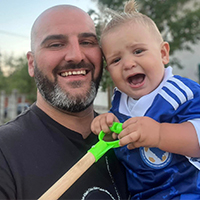Kids and Pets
We surround our children with images of animals from the day they are born. We decorate nurseries with stuffed puppies and penguins and hang mobiles with dangling bears and bunnies over cribs. There are animals on the wallpaper; sometimes we even paint animal murals.
And, later on, we want the kids to experience the joys of having a real animal in the house to grow up with. But sometimes it’s not that easy. If you want to bring home a puppy or a kitten to raise alongside the kids, you’re quite likely to find yourself being given the third degree by an adoption counselor at the local shelter. And that can be quite annoying.
- Adopting a puppy or kitten In my opinion, it’s not a good policy to refuse to adopt a puppy or kitten to people simply because they have a small child, but I do think that extra care and supervision are needed in this situation. At Best Friends, we highly encourage anyone with small children to come to the Sanctuary as a family to meet and adopt a puppy or kitten so the right match is made. If we are placing an adult dog or cat with a family that includes small children, we match the family with an animal who is used to being around children.
- Households with pets and children
Children do need animals in their lives, and animals can have a magical effect on children. They provide comfort, companionship, life lessons, opportunities to learn how to care for something outside of oneself, and, in many cases, a healing touch. However, bringing an animal into a family should be a privilege and done in a way that is safe for both child and animal. A successful adoption is based on the parents’ careful supervision and commitment to making it work safely for the pet and the child. As a mother of three children, I waited for my children to be out of the toddler phase before bringing pets into the mix. They were rough enough on me — hair pulling, jumping on me in the bed — and I didn’t want them to do that to a dog or cat. Other families have made different decisions, and in some cases it has worked out well. A woman named Wendy told me that her oldest daughter was only three years old when Duke came to live with them as an eight-week-old German shepherd puppy. “Lacie would pull on his ears, and she tried to put her hands in his mouth all the time, but he never tried to bite or scratch her,” Wendy told me. Wendy and her family lucked out with Duke. Shelters and humane societies are full of animals who failed the kid test. Many years ago, I placed a nine-week-old puppy with a young mother who had a three-year-old son. The son had really impressed me, but two weeks later, the puppy was dead. How could this have happened? The little boy had discovered the joy of throwing things. One day he was throwing his toys down the stairs. His trucks and his teddy bear all landed fine at the bottom, but not the puppy, who broke his neck in the fall. The distraught mother’s tears and regret were genuine. She agreed that it would be a while before they brought another animal into their home, and then it would be a large adult dog. She was not a bad mother, and this was not a bad child. It was just a bad combination at that age.
A recent study reveals that children raised with animals are less likely to develop allergic reactions to animals, so that is an added bonus to having animals already in the house when the kids start arriving.
Murat Duric
Animals and children do have a special relationship. They always want to tell you about their best friend, be it a dog, a cat, a guinea pig, or a goldfish. For many children, their pets are like siblings. They are always there, which can make a latchkey kid feel not so alone coming into an empty house after school. I am a huge fan of children and animals together, but I strongly recommend that parents think it through carefully. The more you understand about what kind of animal is appropriate at each phase of a child’s development, the better the outcome for everyone concerned.





Leave a Comment
Your email address will not be published. Required fields are marked *